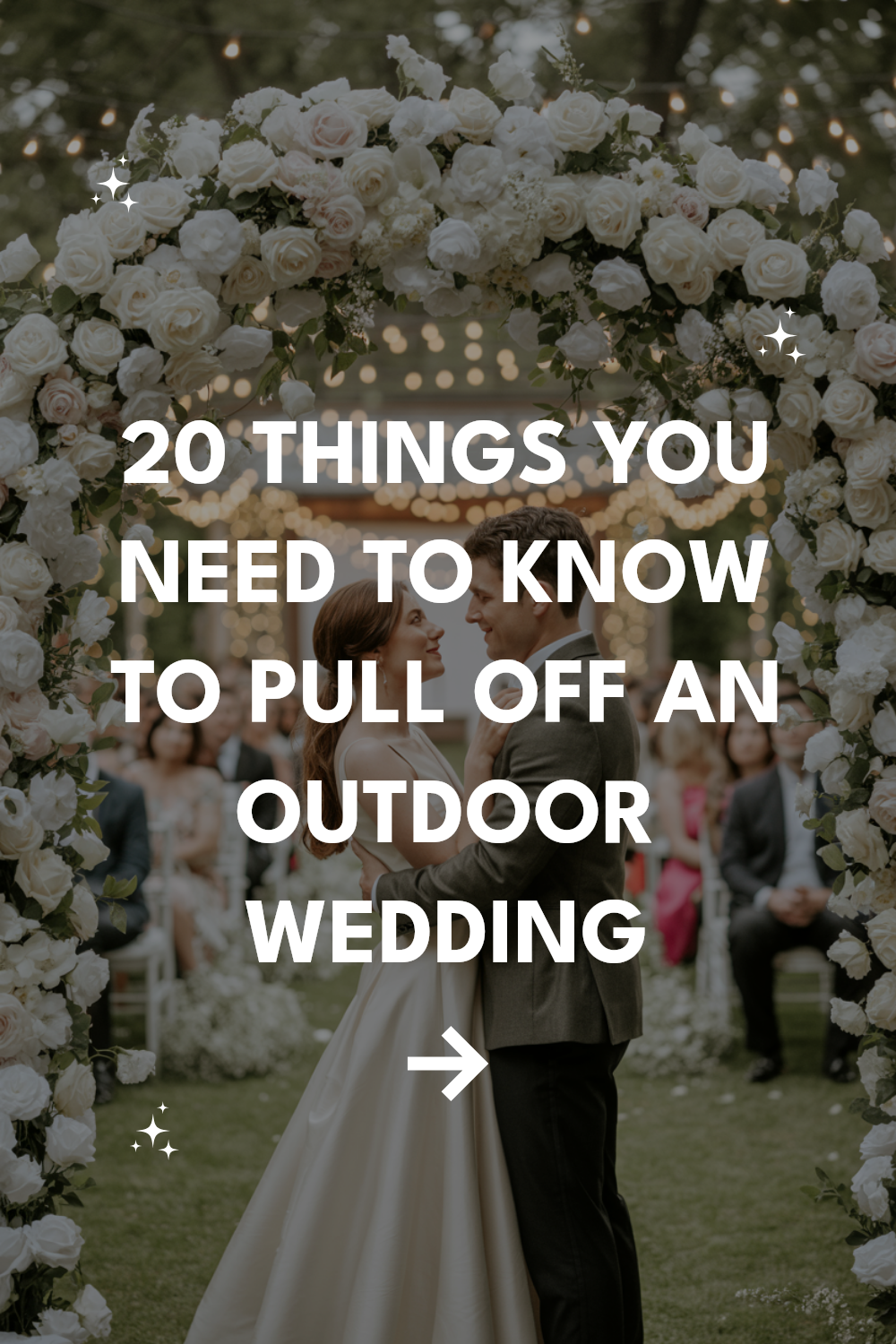Outdoor weddings can be absolutely magical—or complete disasters. The difference lies in the details you plan for and the ones that catch you off guard.
After watching countless couples navigate everything from surprise thunderstorms to ant invasions, here’s what you actually need to know to pull off an outdoor celebration that’s memorable for all the right reasons.
Weather Planning Beyond the Forecast
1. Have a Real Backup Plan
Checking the weather app obsessively won’t save you when Mother Nature decides to crash your party. Your backup plan needs to be more than “we’ll figure it out if it rains.”
Book a tent rental company with a solid reputation and confirm they can deliver and set up on short notice. Some couples opt for a “plan B” indoor venue, but that often means double deposits and complicated logistics.
2. Seasonal Realities Hit Different
Spring weddings sound romantic until you’re dealing with mud season and unpredictable temperature swings. Summer brings heat, humidity, and the occasional pop-up storm that can roll in faster than you can say “I do.”
Fall offers gorgeous foliage but also the possibility of early snow or unseasonably warm days that leave guests sweating in their wool suits. Winter outdoor ceremonies require serious commitment to the vision—and serious heating solutions.
Guest Comfort Comes First
3. Seating That Actually Works
Folding chairs on uneven ground become torture devices after twenty minutes. Your 85-year-old grandmother shouldn’t have to navigate a lumpy field in heels to witness your vows.
Consider renting a temporary flooring system for the ceremony area, especially if you’re dealing with soft ground or slopes. It’s an expense that pays dividends in guest comfort and vendor setup ease.
4. Temperature Control Is Non-Negotiable
Outdoor heaters aren’t just for winter weddings—spring and fall evenings can turn chilly fast. Rent enough units to cover your entire space, not just the dance floor.
For summer celebrations, think beyond pretty paper fans. Misting stations, portable shade structures, and strategically placed water stations can mean the difference between guests enjoying themselves and guests making early exits.
Logistics That Make or Break Everything
5. Power and Lighting Strategy
Generators aren’t romantic, but they’re essential. Your caterer needs power, your DJ needs power, and your photographer needs good lighting for those golden hour shots.
Plan for more electrical capacity than you think you need. Running extension cords across a field creates trip hazards and limits your layout options.
6. Restroom Reality Check
Portable restrooms have come a long way, but they’re still portable restrooms. Upgrade to trailer-style facilities with running water and proper lighting—your guests will thank you.
Position them close enough to be convenient but far enough away to avoid any unpleasant surprises during your ceremony. Include a basket of amenities and perhaps a small mirror for touch-ups.
Vendor Coordination Challenges
7. Setup and Breakdown Logistics
Outdoor venues often lack the infrastructure that makes indoor events run smoothly. Vendors need clear access routes, level surfaces for equipment, and detailed timelines that account for weather delays.
Create a comprehensive site map showing vendor locations, power sources, and backup areas. Share this with every vendor weeks before the event, not the morning of.
8. Catering Complications
Food safety becomes significantly more complex outdoors. Hot foods need to stay hot, cold foods need to stay cold, and everything needs protection from wind, dust, and insects.
Discuss food service logistics extensively with your caterer. Some dishes that work beautifully indoors become problematic when served outside—think about practicality over Pinterest-perfect presentations.
Sound and Entertainment Considerations
9. Acoustic Challenges
Sound carries differently outdoors, and competing with wind, traffic, or natural sounds requires professional equipment. Your officiant’s voice needs to reach the back row without overwhelming the front.
Wireless microphones can fail at the worst moments, so insist on backup systems. Consider the acoustics for your reception too—music that sounds perfect during setup can become muddy or too quiet once guests arrive.
10. Entertainment Adaptations
DJs and bands face unique challenges outdoors, from protecting equipment to dealing with power fluctuations. Discuss contingency plans for equipment failures and weather-related issues.
Live music can be stunning outdoors but requires additional considerations for instrument protection and amplification. String quartets sound magical until the wind picks up and starts blowing sheet music around.
Ground Conditions and Safety
11. Site Preparation Essentials
Even the most beautiful meadow needs preparation for an event. Uneven ground, hidden holes, and soft spots can create safety hazards and setup nightmares.
Walk your venue thoroughly with your planner and key vendors. Mark any problem areas and discuss solutions—whether that’s leveling, covering, or simply avoiding certain spots.
12. Accessibility Considerations
Outdoor venues can present significant accessibility challenges. Wheelchairs and walkers don’t navigate grass and gravel easily, and uneven terrain can be dangerous for guests with mobility issues.
Temporary walkways and ramps might be necessary, and these need to be sturdy enough to handle the weight and wide enough for comfortable passage. Don’t treat accessibility as an afterthought.
Timing and Schedule Flexibility
13. Ceremony Timing Strategy
Golden hour photography is gorgeous, but late afternoon ceremonies can mean harsh lighting during your actual vows. Consider how the sun’s position will affect both your photos and your guests’ comfort.
Build buffer time into your schedule for weather delays, vendor setup issues, and the general unpredictability of outdoor events. Rushing never looks elegant.
14. Reception Flow Adjustments
Outdoor receptions often require different pacing than indoor events. Cocktail hours might need to be shorter if temperatures are dropping, or longer if you’re waiting for optimal lighting.
Plan for natural transition points that work with your outdoor setting. Moving from ceremony to cocktails to dinner should feel seamless, not like a complicated logistics exercise.
Decor and Setup Realities
15. Wind-Resistant Decorations
Beautiful ceremony programs become litter when the wind picks up. Lightweight decorations need serious anchoring, and some Pinterest-perfect ideas simply won’t work outdoors.
Choose decor that enhances your natural setting rather than fighting against it. Heavy bases, weighted elements, and flexible arrangements will serve you better than delicate, precarious displays.
16. Natural Enhancement vs. Overdoing It
The best outdoor weddings work with their environment rather than trying to recreate an indoor ballroom in a field. Embrace the natural beauty that drew you to an outdoor celebration in the first place.
Sometimes less is more—a stunning natural backdrop doesn’t need to be covered with excessive decorations. Let the setting shine while adding thoughtful touches that complement rather than compete.
Photography and Videography Considerations
17. Lighting Challenges and Opportunities
Outdoor lighting changes constantly, creating both opportunities and challenges for photographers. Discuss timing, backup plans, and equipment needs with your photographer well in advance.
Harsh midday sun can be as problematic as dim evening light. Your photographer needs to understand your venue’s lighting conditions throughout the day to capture the best possible images.
18. Weather Protection for Equipment
Professional photographers and videographers have weather protection for their equipment, but extreme conditions can still cause problems. Discuss contingency plans for equipment failures and weather-related issues.
Consider how weather might affect your photo timeline. Rain might cancel outdoor portraits, but it could also create stunning dramatic shots if everyone’s prepared for the conditions.
Final Preparations and Day-Of Essentials
19. Emergency Kit Essentials
Outdoor weddings require more comprehensive emergency kits than indoor events. Include items for weather protection, insect control, and basic first aid beyond the usual touch-up supplies.
Assign someone reliable to manage the emergency kit and know where everything is located. The bride shouldn’t be dealing with logistics on her wedding day.
20. Communication Systems
Cell service can be spotty at outdoor venues, and coordinating vendors becomes more challenging when you can’t reach people. Consider renting walkie-talkies for key vendors and wedding party members.
Establish clear communication protocols before the event. Everyone should know who to contact for different types of issues and how to reach them.
Making Peace with Imperfection
Outdoor weddings will never be as controlled as indoor events, and that’s part of their charm. Embrace the unpredictability while planning for the most likely scenarios.
The couples who enjoy their outdoor weddings most are those who plan thoroughly but remain flexible. Your perfect day might not look exactly like your Pinterest board, but it can still be absolutely magical.


